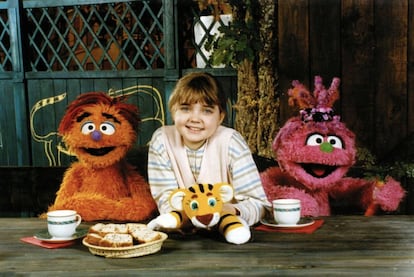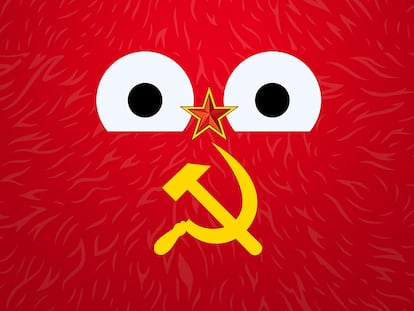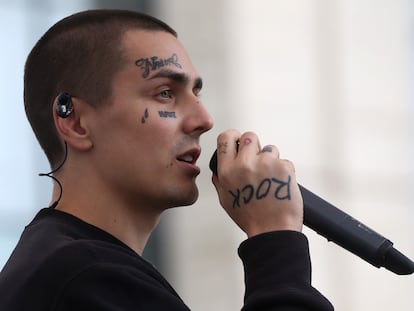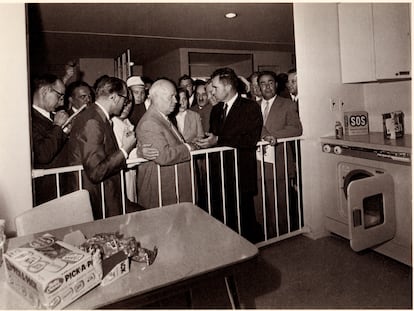The kidnapping of Elmo in Moscow, or how ‘Sesame Street’ got to Russia
A recent book narrates the saga of an American woman who helped the most beloved children’s show in the West cross the Iron Curtain


Who doesn’t know and love Sesame Street and all its furry residents? The show, which debuted in November of 1969, was the brainchild of Joan Ganz Cooney, Lloyd Morrisett and master puppeteer Jim Henson. Ganz Cooney, an early childhood educator, provided the pedagogical instinct and the hippie idealism; Morrisett, an experimental psychologist, the drive to explore the possibilities of television with creativity and a scientific spirit; and Henson contributed the most essential part – the puppets. A whole universe of stuffed creatures that would later serve as the basis for the world-famous Muppets franchise.
From that first season (1969-70), when it received more than 20 awards, including three Emmys, Sesame Street garnered tremendous critical and public success. For journalist Sonia Torre, it was nothing short of a TV revolution: “it had the ability to educate us without future generations realizing it.”
Five years later, the show had been exported and adapted to several countries, including Spain, Germany, Sweden, Italy, France, Mexico, Canada, the United Kingdom, Brazil and Kuwait, to be followed later by all of Western Europe, Latin America and much of Africa, Asia and Oceania. By the mid-1980s, half the children in the planet were spending part of their childhoods in that far-reaching American neighborhood that was Sesame Street.
An unexpected job opportunity
Natasha Lance Rogoff is a self-designated child of the Sesame Street generation. She is also an American writer who recently published a book, Muppets in Moscow, The Unexpected Crazy True Story of Making ‘Sesame Street’ in Russia, where she explains how the show managed to cross one of the most fiercely guarded ideological borders in the world, reaching all the way to Moscow. Even if it was not during the Cold War, but in 1996; that is, seven years after the giant with feet of clay that was the Soviet Union gave way to the Russian Federation of Boris Yeltsin and its fragile and short-lived democratic experiment. The story is as strange as it is fascinating. The writer lived it first-hand and, as she herself says with a hint of humor, is one of the main people involved “who lived to tell the tale.”

Born in New York City, Lance Rogoff, 62, became familiar with Russian culture through the eyes of authors like Tolstoy, Dostoyevsky and Chekhov, the writers that made the greatest impact on her as a teenager. After studying Russian in college, she obtained a scholarship for an international exchange program that allowed her to settle in Leningrad (today Saint Petersburg) when she was 22. There she met artists and dissidents and began working as a correspondent for US media such as the San Francisco Chronicle, which commissioned her to write a series of articles on the slow but steady emergence of the gay subculture in the Soviet Union.
In the fall of 1983, she entered a marriage of convenience with a friend who needed an alibi to avoid being punished for his sexual tendencies. This initially trivial act of camaraderie ended up burying Lance Rogoff’s aspirations to pursue a diplomatic career: when she returned to the United States in 1986, a job interview at the FBI headquarters made her realize that an American who had lived several years in the Soviet Union and had married a Russian citizen would always be suspected of collusion with the enemy. Her country’s government was not going to hire her, so she was forced to look for alternatives.
Those alternatives would eventually present themselves in Moscow, where she moved in the early 1990s. And the best, the most exciting and peculiar of the jobs that her knowledge of Russia would provide her with was that of general supervisor of the project to export Sesame Street to the Russian Federation.
When Lance Rogoff joined the production team in 1993, three years before the show finally landed on the small screen, the talks were well under way, but had not quite come to fruition yet. In an interview with The Guardian, she explains: “When we were developing the Slavic muppets, the creative team initially said, ‘We don’t want your muppets; we have our own revered puppet tradition dating back to the 16th century.’”
Lance Rogoff defines those preliminary conversations as a culture clash of epic proportions that lasted for months. However, her involvement in the project helped clear the way, as the Russian team became more receptive once they realized that the unofficial representative of the US in the operation was a woman who spoke their language and knew and valued their culture.
Rejection became negotiation. Some characters from the original version seemed more exportable than others, and the Russian representatives felt that some of the contents had to be tailored to the local sensitivities so that Russian children – raised in an ecosystem that was nothing like America’s society of “capitalism and consumerism” – would be able to understand them.
Balloons for all, or none at all
Lance shares several examples of the efforts to translate American children’s pedagogy into the peculiarities of the Russian context. The funniest and most significant is a debate that took place regarding the script of a simple piece in which they tried to explain to Russian children the difference between being sad and being happy.
In the script, a boy and a girl walked through a park together with balloons in their hands. The boy’s balloon escaped and, consequently, he became sad. The Russian scriptwriters suggested that the girl also release her balloon in an act of “altruism,” so that her playmate would stop mourning his loss and become happy again.
Lance was baffled and dared, for once, to make a direct objection to the idea of the local writing team, whose criteria she usually respected. “Wouldn’t it be better if the girl offered to share the remaining balloon with the boy?” Better one balloon for two than a pair of empty hands, right?
Wrong. From the point of view not only of the authors of the script, but also of the team of child psychologists who were advising them, the solution proposed by their “American friend” would amount to surrendering to the logic of Western capitalism, which, they said, clings to material values because it considers them more important than human values, such as friendship. The real lesson should be that you do not need toys if you have friends. More so if those friends are willing to give up their toys just to make you happy. Or to share your grief.
The Russia that could not be
Lance acknowledges that there was something poetic (absurd, too) in that way of conceiving the kind of life lessons that should be taught to children. The team of idealists who worked on Ulitsa Sezam believed in good faith that they were contributing to the consolidation of Russian democracy with this attempt to import freedom and respect for diversity from the West without renouncing the sense of equity and solidarity of the former Soviet Union. And, above all, without succumbing to capitalist greed.
Unfortunately, as Masha Gessen explains in her formidable essay The Future Is History: How Totalitarianism Reclaimed Russia, in Yeltsin’s Russian Federation a new class of predators was already emerging: the future oligarchs, ready to embrace the most brutal capitalism and split the spoils of the Soviet collapse. For them, it was not a question of letting go or sharing the remaining balloon – it was about keeping all the balloons, their own and others’, and slicing the throats (both literally and metaphorically) of those who did not relinquish theirs nicely.
In her book, Lance Rogoff also talks about the accelerated transition to a post-Soviet (dis)order that left several corpses in the gutter, starting with that of democracy itself. One of the closest collaborators of the show, Vladislav Listyev, a television journalist and pro-democracy activist, was assassinated in 1995, months before Ulitsa Sezam saw the light of day.

He was not the only one. Several Russian TV executives and professionals who worked with Lance Rogoff in the process of gestation and consolidation of the project would also suffer violent deaths during those iron years in which almost anyone, especially if they threatened the interests of the new criminal oligarchy that was taking over the country, could end up being visited by a hit man.
One time, Lance Rogoff herself felt the whistle of the bullets: it was the late 1990s, Ulitsa Sezam was already on the air and a group of young recruits with assault rifles broke into the production office, ordered the workers to get down on the ground and proceeded to search the facilities in an act that Lance Rogoff still considers terrifying and inexplicable. Were they real soldiers on an official mission, or mercenaries at the service of some obscure private interest?
Whatever it was, they took scripts, sketches and even a full-sized Elmo. Who breaks into a television studio to steal some sketches and kidnap a puppet? The Russian executive producer shrugged it off, declaring that they were probably fans of the show.
Years later, the American writer remembers that adventure as one of her bittersweet youthful experiences in a country where a better future seemed possible until things went downhill. Ulitsa Sezam was a success, especially its first three seasons, and remained on the air until 2007, faithful to the quixotic task of convincing children that joy – not toys – is something that can and should be shared. Lance Rogoff was a producer for the first 52 episodes.
Today, this pioneer of intercultural dialogue reflects that the fledgling democratic Russia that ended up strangled in its cradle had (almost) everything it needed to prosper: enthusiastic young people, honest and creative people eager to turn the page and a generation of children who were being educated with different values, without fear of the future.
Perhaps it lacked a bit of luck and a real opportunity; maybe even some generosity and vision from an international community that wanted to incorporate them quickly into the capitalist order without worrying about almost anything else. Perhaps Elmo’s kidnapping could be seen as a metaphor for the Russian utopia that could not be.
Sign up for our weekly newsletter to get more English-language news coverage from EL PAÍS USA Edition
Tu suscripción se está usando en otro dispositivo
¿Quieres añadir otro usuario a tu suscripción?
Si continúas leyendo en este dispositivo, no se podrá leer en el otro.
FlechaTu suscripción se está usando en otro dispositivo y solo puedes acceder a EL PAÍS desde un dispositivo a la vez.
Si quieres compartir tu cuenta, cambia tu suscripción a la modalidad Premium, así podrás añadir otro usuario. Cada uno accederá con su propia cuenta de email, lo que os permitirá personalizar vuestra experiencia en EL PAÍS.
¿Tienes una suscripción de empresa? Accede aquí para contratar más cuentas.
En el caso de no saber quién está usando tu cuenta, te recomendamos cambiar tu contraseña aquí.
Si decides continuar compartiendo tu cuenta, este mensaje se mostrará en tu dispositivo y en el de la otra persona que está usando tu cuenta de forma indefinida, afectando a tu experiencia de lectura. Puedes consultar aquí los términos y condiciones de la suscripción digital.
More information
Últimas noticias
Most viewed
- Sinaloa Cartel war is taking its toll on Los Chapitos
- Oona Chaplin: ‘I told James Cameron that I was living in a treehouse and starting a permaculture project with a friend’
- Reinhard Genzel, Nobel laureate in physics: ‘One-minute videos will never give you the truth’
- Why the price of coffee has skyrocketed: from Brazilian plantations to specialty coffee houses
- Silver prices are going crazy: This is what’s fueling the rally










































